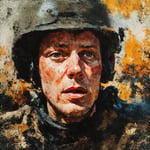The painting is a silkscreen print on canvas that depicts a scene from a contemporary war. The image is a close-up of a soldier's face, who is in the midst of battle. The soldier's expression is one of pure terror, and his eyes are wide with fear. His face is covered in dirt and blood, and his uniform is torn and ragged. In the background, there is a blur of activity, as other soldiers fight and die. The overall impression of the painting is one of chaos and violence.
Additional Details
The soldier's face is the only recognizable object in the painting. The rest of the image is a blur of colors and shapes.
The colors in the painting are bright and garish, which adds to the sense of chaos and violence.
The painting is made up of many small dots of color, which is a characteristic of Warhol's silkscreen printing technique.
Interpretation
The painting can be interpreted in a number of ways. On one level, it can be seen as a commentary on the horrors of war. The soldier's terrified expression and the chaotic scene around him convey the brutality and senselessness of war.
On another level, the painting can be seen as a critique of the way that war is often portrayed in the media. The use of bright, garish colors and the blurring of the background figures make the scene seem unreal and dreamlike. This suggests that war is often sanitized and romanticized in the media, which can make it easier for people to accept and even glorify it.
Overall, the painting is a powerful and disturbing work of art that forces the viewer to confront the realities of war. It is a reminder of the human cost of conflict, and it challenges us to think critically about the way that war is represented in our society.
Additional Information
The painting is titled "War" and it was created by Andy Warhol in 1968. It is part of his series of silkscreen prints that depict scenes of violence and tragedy. The painting is now in the collection of the Museum of Modern Art in New York City.

